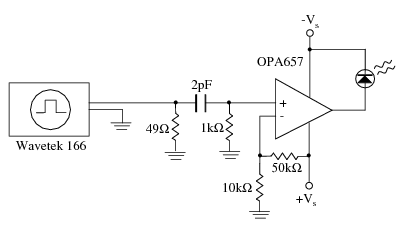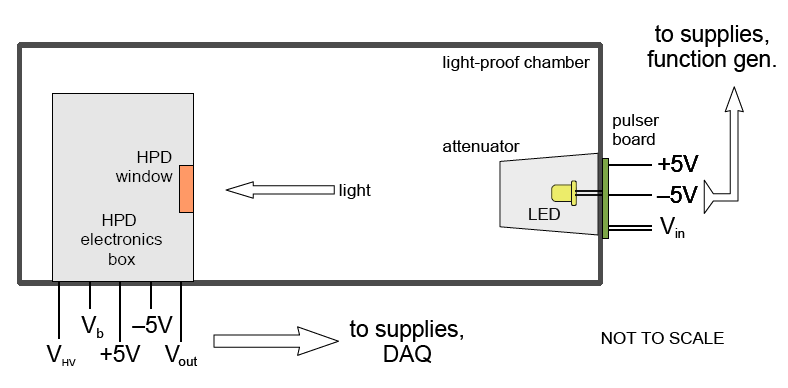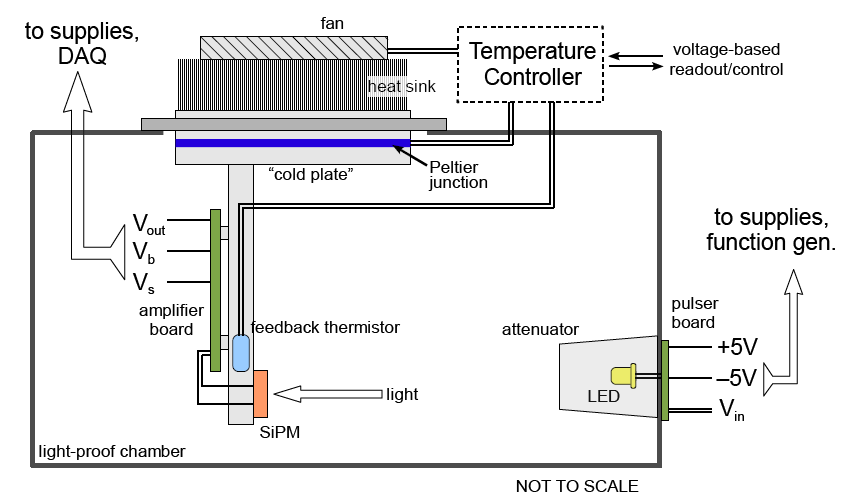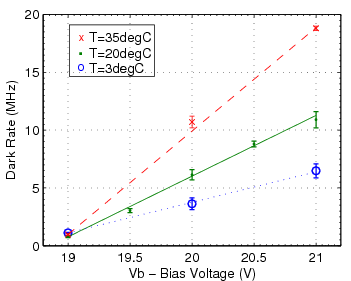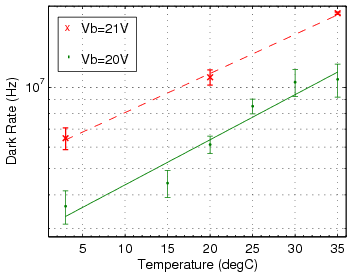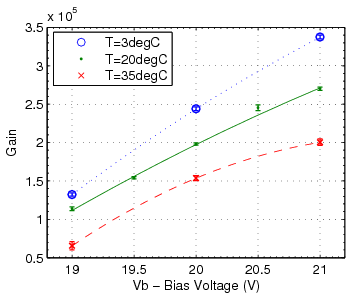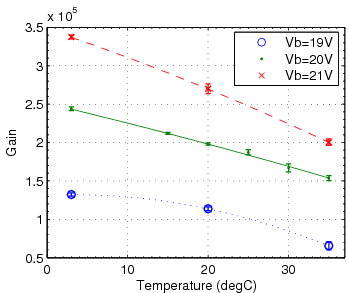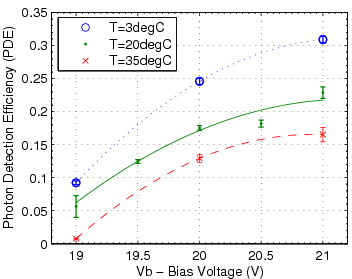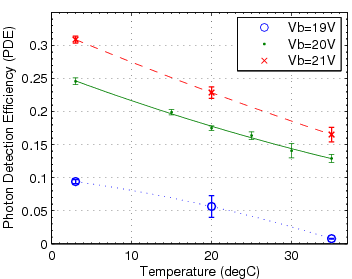Characterizing SiPMs
SiPM Performance Requirements
The tagger microscope consists of many identical and well isolated readout channels, each consisting of a several cm long scintillating fiber connected to a clear acrylic fiber light guide. A tagging electron travels axially down the length of a scintillating fiber depositing 4 MeV of energy in the fiber, resulting in 1600 scintillation photons within the forward capture cone of the fiber. Assuming that 80% of these are delivered to the SiPM active surface and a conservative estimate of 15% for the efficiency of the SiPM leads to an estimate of 190 for the average SiPM pixel count per event. Monte Carlo simulations have shown that an efficient detection threshold corresponds to 40% of the average pulse height, or 80 SiPM pixels. This implies a requirement for the dark rate that spontaneous pulses never exceed 80 pixels.
The large photon yield expected at the end of the light guide does not demand unusual detection efficiency on the part of the SiPM. For example, 10% efficiency with the above number of photons still yields a signal of 130 photons. However, given that the scintillator (BCF-20) has a finite decay time (2.7ns) the more photons are produced the more clearly resolved is the time of the pulse.
The device is expected to have a high enough gain (measured in electrons per photon detected) - around 106. in order for such a small light signal to be recorded by conventional electronics. Such devices are also susceptible to spurious, thermally excited pixel breakdowns, each showing up as a single photon hit ("dark count"). High rate of these single-pixel events may create a pileup above the signal threshold. All of the above parameters (detection efficiency, gain and "dark rate") depend on applied bias voltage and temperature. Stability of performance despite expected fluctuations of these variables is an important requirement.
Another criterion in SiPM selection is its dynamic range. Although this readout device essentially provides digital output - scintillation detected or not - enough of a range is necessary to set a threshold above the noise floor and to account for some pixels being not having required from a previous hit .
Bench Test Setup
A wooden dark box was initially constructed for the a hybrid photo-diode (HPD) module DEP PP0350. A pulser was installed on the opposite end of the box composed of a fast LED driven by a pulser circuit shown on the right.
Running this setup with an HPD of known characteristics allows us to calibrate the light intensity. The SiPM detection efficiency can then be characterized relative to the HPD. The signal from the SiPM was clean enough to distinguish peaks corresponding to discreet photon (pixel) counts in the histogram signal integrals. Therefore, the gain of the SiPM was found independently of the HPD - they were self-calibrating!
Below are the diagrams of the dark box with the HPD and SiPM assemblies installed. A temperature controller system (TE Tech. TC-24-12) was procured, which operates by driving a Peltier junction based on feedback from a thermistor compared to voltage-specified reference temperature. It was calibrated and installed into the wall of the dark box via a custom-designed light-tight frame.
SiPM Measurements
The first remarkable feature of the the SiPM statistics is the presence of discrete peaks in the histogram of charge collected in the SiPM(proportional to the SiPM signal (Volts) integral (Vs) by 1/Gaintrans-impedance (V/A). This allows us to determine the charge collected per activated pixel (per photon) and therefore gives the gain of the device. This is the "self-calibration" referred to above.
| Device | Gain | PDE (yellow) | Dark Rate | |||
|---|---|---|---|---|---|---|
| Nom. | Meas. | Nom. | Meas. | Nom. | Meas. | |
| SSPM-050701GR-TO18 [1] | 0.8×106 | 1.1×106 | ~29% | ~30% | 10 MHz | 9.8 MHz |
| SSPM-0606BG4-PCB [2] | 1.5×105 | 2.5×105 | 27% | 20-23% | 15 MHz | 8.9 MHz |
Links
Written and last edited by Igor Senderovich 23:47, 8 August 2007 (EDT)
